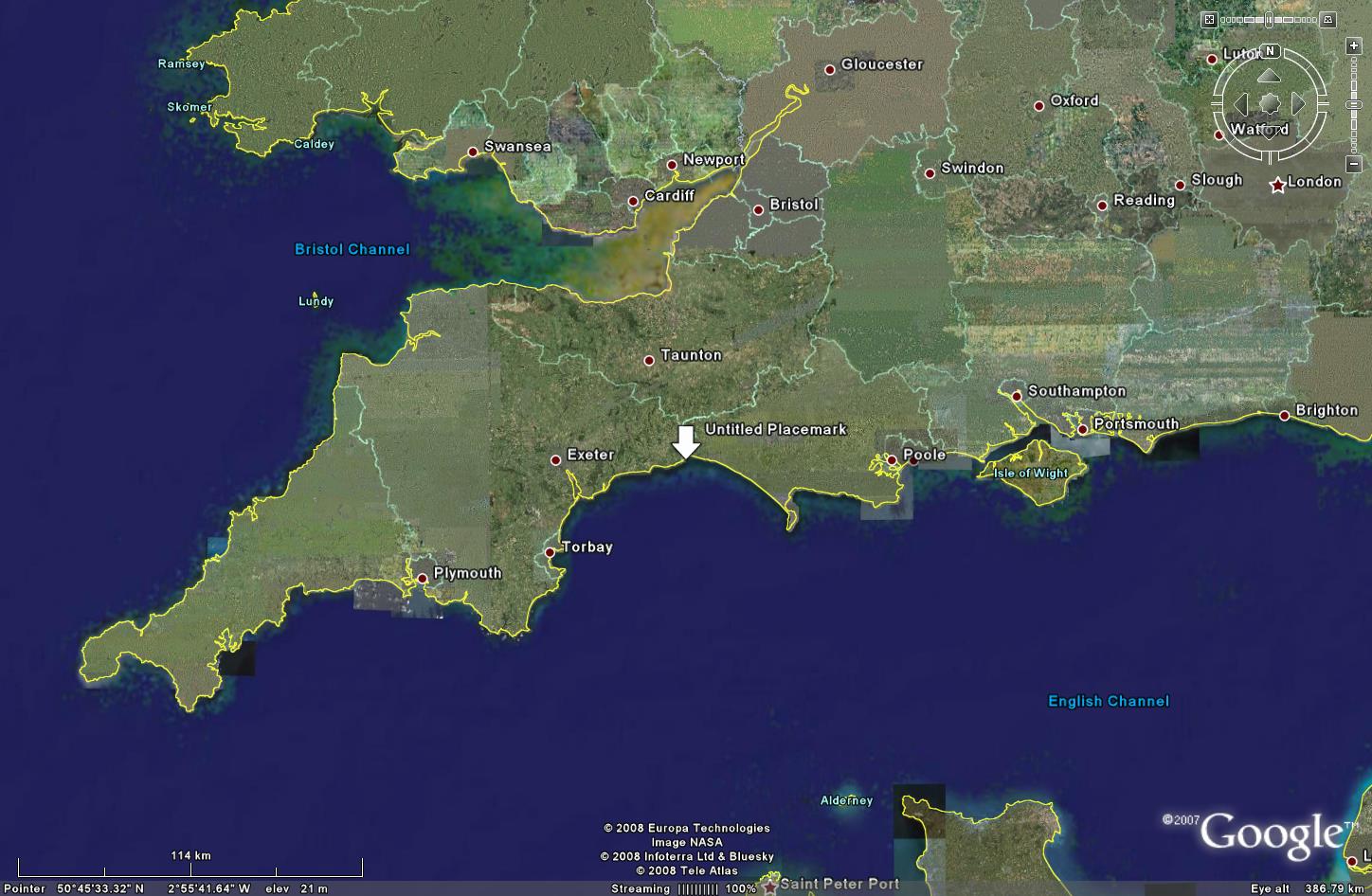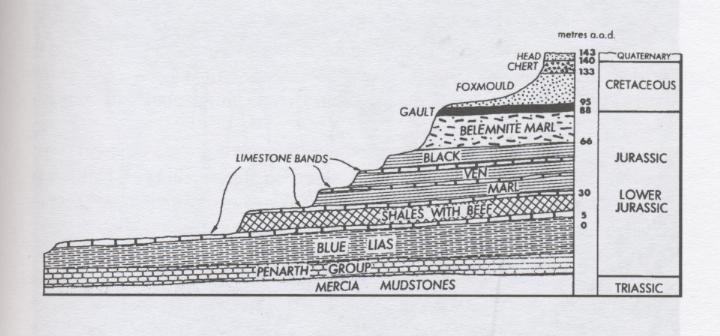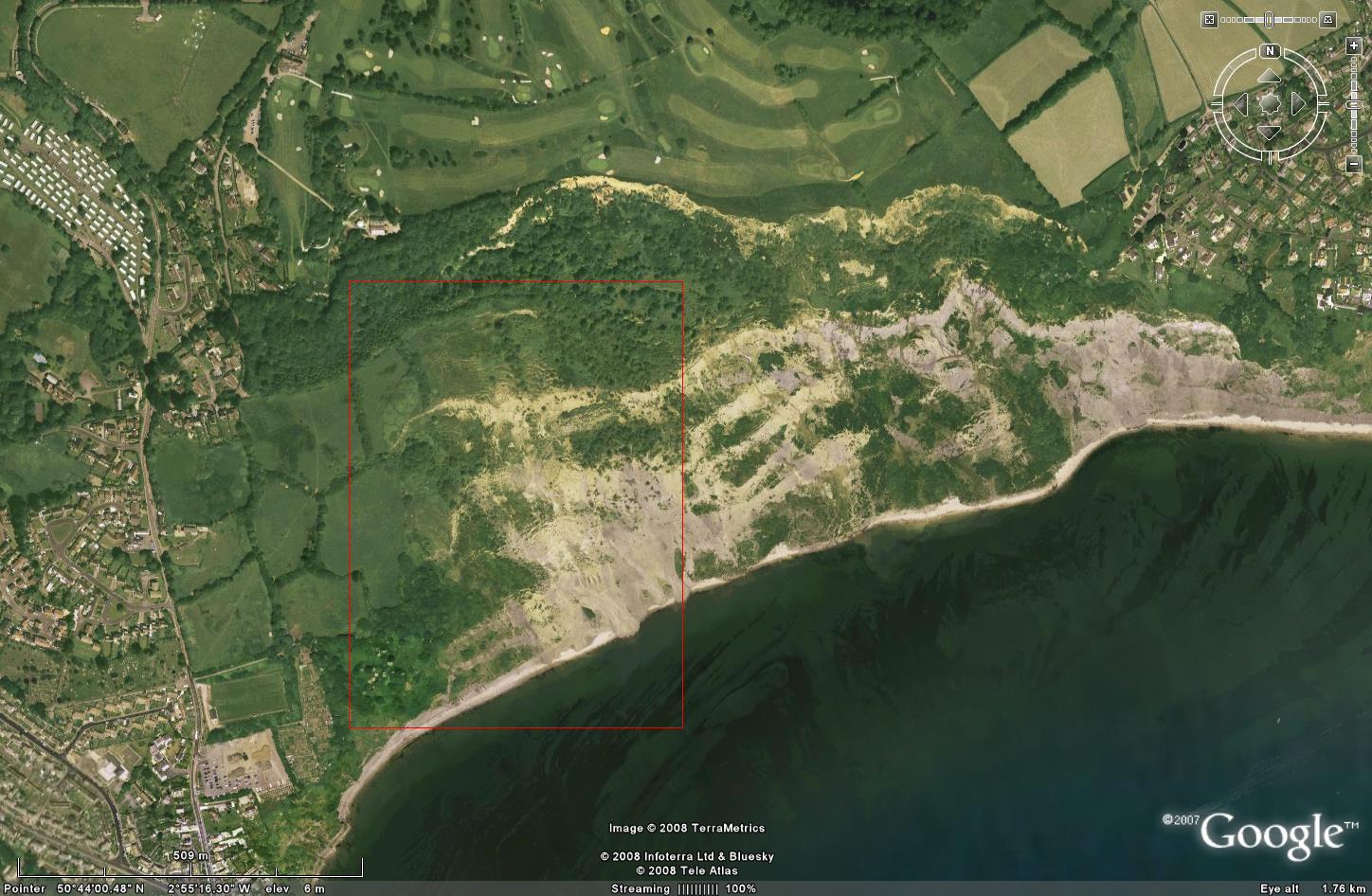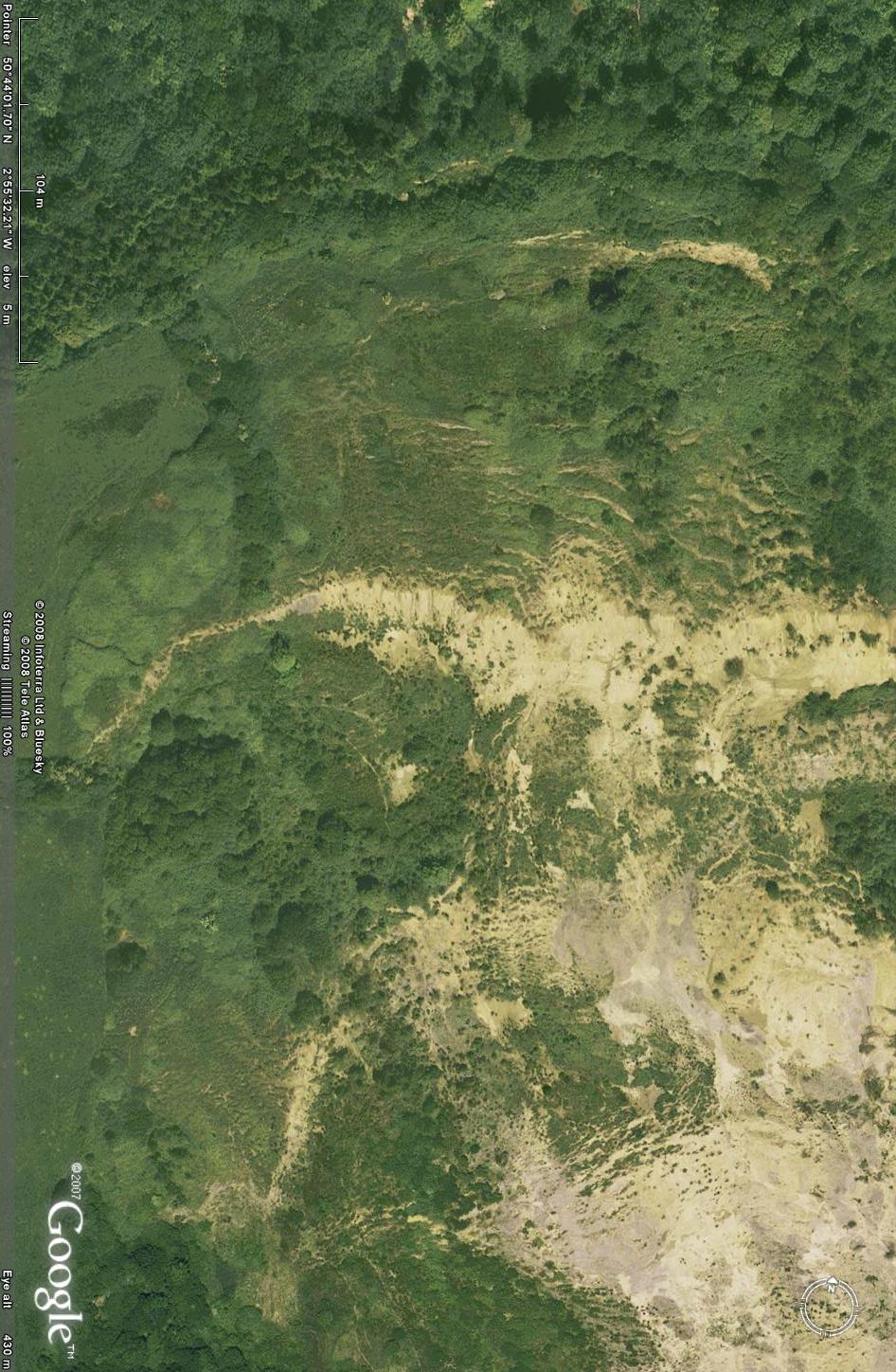7 May 2008
Black Ven landslide in Dorset
Posted by Dave Petley
NOTE: see follow-up blog here, outlining why this landslide is not as large or significant as was initially reported.
——————-
Update: ITV have a low res video of the landslide site here. This confirms the general location and shows that the failure is indeed large.
——————-
Update 2: The BBC now have some good aerial footage of the landslide here. It is slightly intriguing as it appears that the slide is wide but not very long. From a preliminary view there should be real concern about what might happen here in the next heavy rainfall event.
——————-
Update 3: Based upon the BBC footage, the failure area appears to be the lower part of the slope highlighted by the red box on Fig. 3 below. The landslide appears to be a 400 m wide section of this lower cliff, extending about 100 m inland. This is a really intriguing development. It will be interesting to see how the sections upslope now behave as they have lost their toe support. This will be a fascinating landslide to watch over the next few months. I suspect that we have not seen the last movement at this site as yet.
——————-
Original text:
Timed to perfection to coincide with the launch of the Durham University Institute of Hazard and Risk Research tomorrow, news reports indicate that there as another major landslide in the UK overnight. This time the failure occurred on the well-known Black Ven landslide system in Dorset, the site of a great deal of landslide research over the last few years.
 Black Ven is shown by the arrow on the Google Earth image to the left, located on the south coast of England, just east of the town of Lyme Regis in Dorset. It is a big, active landslide complex consisting of an upper section in a glauconitic sandstone known as Foxmould. The lower part consists mainly of a series of shales and marls with thin limestone bands that form benches in the landscape. This is quite well shown in the cross section in Fig. 1 (Koh 1992). NB Click on any image for a better view.
Black Ven is shown by the arrow on the Google Earth image to the left, located on the south coast of England, just east of the town of Lyme Regis in Dorset. It is a big, active landslide complex consisting of an upper section in a glauconitic sandstone known as Foxmould. The lower part consists mainly of a series of shales and marls with thin limestone bands that form benches in the landscape. This is quite well shown in the cross section in Fig. 1 (Koh 1992). NB Click on any image for a better view.
 Figure 1: Indicative cross section of Black Ven landslide in Dorset, showing the permeable sandstones of the Foxmould overlying the impermeable shales and marls (Koh 1992). NB Click on any image for a better view.
Figure 1: Indicative cross section of Black Ven landslide in Dorset, showing the permeable sandstones of the Foxmould overlying the impermeable shales and marls (Koh 1992). NB Click on any image for a better view.The landslide is clearly shown in the picture from the 1980’s shown in Fig. 2 (Brunsden et al. 1988). The yellow rocks at the top is the Foxmould, and the grey rocks lower down are the shales. The landslide usually activates because of a deep seated rotational failure in the Foxmould. The rotated blocks then break-down over time to form flows that cross the benches below, eventually flowing out into the sea.
 Figure 2: Photograph of Black Ven landslide in Dorset, showing the permeable yellow sandstones of the Foxmould overlying the impermeable shales and marls (Brunsden et al. 1988). Rotational failures in the Foxmold transition to flows that run across the lower benches. NB Click on any image for a better view.
Figure 2: Photograph of Black Ven landslide in Dorset, showing the permeable yellow sandstones of the Foxmould overlying the impermeable shales and marls (Brunsden et al. 1988). Rotational failures in the Foxmold transition to flows that run across the lower benches. NB Click on any image for a better view. The reports suggest that the landslide occurred in the area known as the Spittles, although I have yet to see any pictures to confirm this. Koh et al. (1992) indicated the location of the Spittles on the sketch map of the landslide shown to the left. This is just to the left of the landslides shown in the photograph in Fig. 2. This is an area that has been showing very considerable slope distress for many years, with lots of evidence of deformation as the toe of the landslide slips away. This area is quite clear on the Google Earth Imagery in Fig. 3 – I have put a faint red box around the general area usually known as the Spittles. Zooming into the upper part of the area delineated in red, the Google Earth image very clearly shows the active deformation that has characterised this zone for a while, with abundant evidence of tension cracks and small scarps (Fig. 4). These have been developing over a long period, so failure should not be a surprise. The landslide is large – the BBC report that it is about 400 m, which appears to be the width. If so this is a notable failure.
The reports suggest that the landslide occurred in the area known as the Spittles, although I have yet to see any pictures to confirm this. Koh et al. (1992) indicated the location of the Spittles on the sketch map of the landslide shown to the left. This is just to the left of the landslides shown in the photograph in Fig. 2. This is an area that has been showing very considerable slope distress for many years, with lots of evidence of deformation as the toe of the landslide slips away. This area is quite clear on the Google Earth Imagery in Fig. 3 – I have put a faint red box around the general area usually known as the Spittles. Zooming into the upper part of the area delineated in red, the Google Earth image very clearly shows the active deformation that has characterised this zone for a while, with abundant evidence of tension cracks and small scarps (Fig. 4). These have been developing over a long period, so failure should not be a surprise. The landslide is large – the BBC report that it is about 400 m, which appears to be the width. If so this is a notable failure.
 Figure 3: Google Earth image of the Black Ven landslide. The red area highlights the zone known as the Spittles, which appears to be the area that has failed in early May 2008. Update: The BBC film footage suggests that the failure has occurred in the lower left side (i.e. SE corner) of this box. NB Click on any image for a better view.
Figure 3: Google Earth image of the Black Ven landslide. The red area highlights the zone known as the Spittles, which appears to be the area that has failed in early May 2008. Update: The BBC film footage suggests that the failure has occurred in the lower left side (i.e. SE corner) of this box. NB Click on any image for a better view. Figure 4: Google Earth image of the Black Ven landslide zoomed in on the upper part of the Spittles. Note the multiple tension cracks and scarps indicating that failure was likely. NB Click on any image for a better view.
Figure 4: Google Earth image of the Black Ven landslide zoomed in on the upper part of the Spittles. Note the multiple tension cracks and scarps indicating that failure was likely. NB Click on any image for a better view.The timing of the failure is quite interesting – it appears that the UK experiencing an exceptional level of landslide activity at the moment (e.g. Cayton Bay). Interestingly, amateur weather stations do not suggest that the weather of late has been exceptionally wet in this area – for example, an amateur station just along the coast at Dawlish suggests that the rainfall total in April was 64.6 mm, which is lower than the totals for both 2006 and 2007. The first few days of May have been essentially dry. The only notable rainfall event of late occurred on 29th April, when 18.5 mm of rain fell. Although high, this is not really exceptional. Rainfall in 2007 was recorded as 916 mm against a long term average of 850 mm (i.e. about 8% above the mean value), but this was below average for the last four months of the year. This pattern continued in January and February 2008. What is interesting is that March was unusually wet (103.5 mm against an average value of 68.1 mm – i.e. 93% above the long term average). I assume that the movement we are seeing is a delayed response to this rainfall period.
I would really welcome any comments, especially from anyone near to the site. Please email me or leave a comment below.
References:
Koh, A. 1992. Black Ven. In Allison, R.J. The Coastal Landforms of West Dorset. Geologists Association, Essex, 67-79.
Brunsden, D., Gardner, R., Goudie, A. and Jones, D. 1988. Land Shapes. Channel 4.


 Dave Petley is the Vice-Chancellor of the University of Hull in the United Kingdom. His blog provides commentary and analysis of landslide events occurring worldwide, including the landslides themselves, latest research, and conferences and meetings.
Dave Petley is the Vice-Chancellor of the University of Hull in the United Kingdom. His blog provides commentary and analysis of landslide events occurring worldwide, including the landslides themselves, latest research, and conferences and meetings.
[…] is Dorset (which incidentally is also one of my favourite parts of the world). It has a series of very large, very well developed landslides, as well as numerous rockfall sites on steep cliffs. Most landslide fatalities in the UK in […]